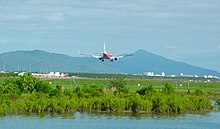Barron River (Queensland)
| Barron | |
|---|---|
Atherton Tablelands | |
| • location | below Mount Hypipamee |
| • coordinates | 17°25′48″S 145°30′48″E / 17.43000°S 145.51333°E |
| • elevation | 1,200 m (3,900 ft) |
Aeroglen | |
• coordinates | 16°51′41″S 145°46′15″E / 16.86139°S 145.77083°E |
• elevation | 0 m (0 ft) |
| Length | 165 km (103 mi) |
| Basin size | 2,138 km2 (825 sq mi) |
| Discharge | |
| • location | Near mouth |
| • average | 29.4 m3/s (930 GL/a)[2] |
| Basin features | |
| Tributaries | |
| • left | Granite Creek (Queensland), Flaggy Creek |
| • right | Peterson Creek (Queensland), Tinaroo Creek, Clohessy River |
| Waterfalls | Barron Falls; Dinner Falls |
| National parks | Mount Hypipamee National Park; Barron Gorge National Park |
| [3][4][5][6][7] | |
The Barron River (
Geography



Over time, some of the Mitchell River's former headwaters were diverted by natural forces into the Barron.[9] These include the Clohesy River and other tributaries that used to flow northwest to the Gulf of Carpentaria. With the extra water now flowing over the 260-metre (850 ft)-high Barron Falls, the steep, narrow Barron Gorge was formed. Much of the water that used to flow over the falls has now been diverted in upstream dams and is used to generate electricity at the Barron Gorge Hydroelectric Power Station.[10]
The Barron's headwaters start in the
The river's catchment area includes the major tributaries flowing into Lake Tinaroo including Kauri, Mazlin, McLean, Maroobi, Peterson and Severin Creeks. It also absorbs most of the major tributaries on the Atherton Tableland, including Emerald Creek, Granite Creek, the Clohesy River and
Before entering the
The river is the sole source of sand for the beaches to the north of Cairns.[11] Sand and gravel extraction from the river bed has supplied growing demand in the Cairns area. In the 1970s and 80s extraction rates reached 90,000 cubic metres (3,200,000 cu ft) per year, which was twice the replenishment rate at the mouth.[11] This has resulted in considerable beach erosion to the north.
History
The river's original Aboriginal name is Bibhoora[
Flooding
The lower reaches of the Barron River have a well-documented history of flooding dating from early last century.
Heavy rain associated with a cyclone early in 1939 caused substantial flooding on the Barron River and resulted in the river changing its course. The mouth of the Barron moved about 2 kilometres (1.2 mi) north from Casuarina Point on the northern Cairns esplanade to Ellie Point.[11]
Some of the river's worst flooding occurred in 1950 when a major tropical cyclone followed the contour of the Queensland coast for over a week.[citation needed]
Rainfall records were broken in December 2023 when
Fauna
The stocking of exotic sports fish into the river has led to a serious decline in the diversity and abundance of native fish.[16]
A total of 63 species of fish have been found in the river, including the glassfish,
See also
- List of rivers of Queensland
- William Walter Mason Bridge
References
- ^ a b "Barron River (entry 1763)". Queensland Place Names. Queensland Government. Retrieved 28 June 2014.
- ^ "East Coastal Watersheds".
- ^ "Map of Barron River, QLD". Bonzle Digital Atlas of Australia. Retrieved 17 June 2015.
- ^ "Map of Barron River (1), QLD". Bonzle Digital Atlas of Australia. Retrieved 22 October 2015.
- ^ "Map of Barron River (2), QLD". Bonzle Digital Atlas of Australia. Archived from the original on 11 August 2016. Retrieved 22 October 2015.
- ^ "Map of Barron River (3), QLD". Bonzle Digital Atlas of Australia. Archived from the original on 26 August 2013. Retrieved 22 October 2015.
- ^ a b "Water resources – Overview – Queensland – Basin & Surface Water Management Area: Barron River". Australian Natural Resources Atlas. Department of the Environment, Water, Heritage and the Arts. Archived from the original on 22 June 2009. Retrieved 23 May 2009.
- ^ "Layers: Locality; Mountains and ranges; Contours; Watercourses". Queensland Globe. Queensland Government. Retrieved 12 March 2024.
- S2CID 140191097.
- ISBN 978-0-9758275-0-5.
- ^ ISBN 978-1107393721. Archivedfrom the original on 6 March 2016. Retrieved 8 September 2015.
- ^ "Stratford Heritage Trail". The Stratford and Freshwater Community Association (SAFCA). Archived from the original on 9 April 2013. Retrieved 13 December 2012.
- ^ Bureau of Meteorology (Australia). Archivedfrom the original on 3 August 2008. Retrieved 23 May 2009.
- ^ a b c Newton, Matthew; McCarthy, Isaac (18 December 2023). "Far North Qld floods: Raw sewage leaking onto Cairns' streets as water supply restarted, Airport ready for flight". The Cairns Post. Retrieved 18 December 2023.
- ^ Turton, Steve (18 December 2023). "Far North Queensland's torrential rains result in record-breaking floods in the wake of Tropical Cyclone Jasper". Australian Geographic. Retrieved 18 December 2023.
- ISBN 0-14-300194-9
- ^ "Barron River catchment". Fish Atlas of North Australia. Archived from the original on 30 June 2015. Retrieved 28 June 2015.
